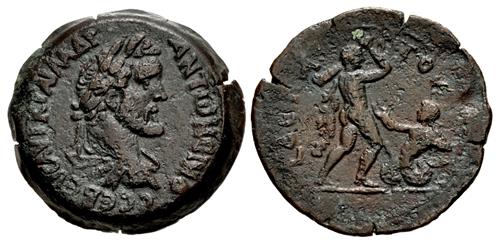
|
Antoninus Pius. AD 138-161. Æ Drachm (35mm, 24.37 g, 12h). Labors of Herakles series. Alexandria (Egypt) mint. Dated RY 10 (AD 146/147).
Triton XXIII – Session Three – Roman Imperial Coinage Part II through World Coinage Part I
Lot: 754. Estimated: $ 2 000
Roman Imperial, Bronze
Sold For $ 7 000. This amount does not include the buyer’s fee.
Go to Live
|
|
Antoninus Pius. AD 138-161. Æ Drachm (35mm, 24.37 g, 12h). Labors of Herakles series. Alexandria (Egypt) mint. Dated RY 10 (AD 146/147). AVT K T AIΛ A∆P ANTωNЄINO C CЄB ЄVC, laureate, draped, and cuirassed bust right / Hercules and the Lernaean Hydra – Hercules standing right, lion skin over his left shoulder, holding club overhead with his right hand; before him; the anthropomorphized Lernaean Hydra holding her right arm-tentacle upward; L ∆Є[K]A TOV (date) around. Köln 1537 (same dies); Voegtli Type 2 (pl. 12d – same rev. die as illustrated specimen); Dattari (Savio) 2600 & 8488; K&G 35.348 (same dies as illustrated specimen); RPC IV.4 Online 14887; Emmett 1546.10 (R2). Dark brown patina with touches of green, some roughness, a bit of smoothing in the right obverse field. VF. Rare.
For his second labor, Herculess had to kill the Lernaean Hydra, the offspring of Typhon and Echidna, and the sibling of the Nemean Lion, the Chimaera, and Kerberos. Inhabiting the swamp near Lake Lerna in the Argolid, the creature possessed numerous mortal and one immortal head on its single body; should one head be removed, two more would grow in its place. When Hercules reached the swamp where the Hydra dwelt, he drew it out of its lair near the spring of Amymone. Thereupon, wielding a harvesting sickle, he attempted to decapitate the creature. When this proved unsuccessful, because of the Hydra’s regenerative ability, Hercules enlisted the assistance of his nephew Iolaos, who devised a plan: once Hercules had cut off one of the creature’s heads, Iolaos would cauterize the stump with a burning firebrand. The plan succeeded, and the Hydra was destroyed. Hercules placed its one immortal head under a large rock on the sacred way between Lerna and Elaius and dipped his arrows in its poisonous blood.
On this rare Alexandrian type, Hydra is anthropomorphized as a giantess, which has been interpreted in the past as “the giantess Echidna raising her son Hydra against Herakles in defense.” It remains a mystery as to why the engravers at the Alexandrian mint chose this non-canonical interpretation for the Lernaean Hydra, especially when other provincial mints that struck coins for the various labors used the more traditional representation.
The final winners of all Triton XXIII lots will be determined at the live public sale that will be held on 14-15 January 2020. Triton XXIII – Session Three – Roman Imperial Coinage Part II through World Coinage Part II will be held Wednesday morning, 15 January 2020 beginning at 9:00 AM ET.
Winning bids are subject to a 20% buyer's fee for bids placed on this website and in person at the public auction, 22.50% for all others.
|
